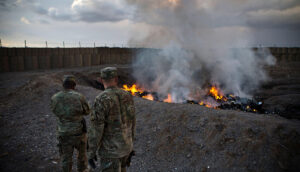VA Presumptive Injury Evidence Synthesis

When we think of wartime hazards, we typically envision enemies, bombs, and bullets. Most people do not consider drawing the next breath as a potentially life-threatening activity. However, during the US military’s engagements in the Middle East between 1990 and 2021, the simple act of breathing posed a health hazard. Burn pits and other airborne hazards, which we are only now beginning to understand, put US soldiers at risk.
It has been suggested that there is insufficient evidence to conclude with certainty that exposure to burn pits is associated with certain respiratory diseases in those returning from the Southwest Asian theater of operations (National Academies of Sciences Engineering and Medicine (U.S.). Committee on the Respiratory Health Effects of Airborne Hazards Exposures in the Southwest Asia Theater of Military Operations et al., 2020). However, these conclusions partly stem from challenges in measurement, study design, underlying assumptions, and an overly cautious approach instead of striving for equipoise (Samet et al., 2008).
The VA, which has been operating since 1930, has garnered recent attention with the passing of the Promise to Address Comprehensive Toxics (PACT) Act in 2022. The PACT Act expanded the VA’s benefits and healthcare to veterans who have been exposed to toxic exposures (burn pits and other airborne hazards). In collaboration with the VA, Rutgers University is addressing these issues by establishing a dynamic “living” evidence repository, capable of continuous updates as new information emerges.
This project serves as a framework and infrastructure for the ongoing extraction, review, and summarization of evidence. This effort is crucial because, as studies show, traditional systematic reviews tend to yield incorrect conclusions within two years if not regularly updated (Shojania et al., 2007). The project team is constructing multiple evidence repositories on the US Agency for Healthcare Research and Quality’s (AHRQ) Systematic Review Data Repository Plus+ platform (www.srdr.ahrq.gov).
References:
National Academies of Sciences Engineering and Medicine (U.S.). Committee on the Respiratory Health Effects of Airborne Hazards Exposures in the Southwest Asia Theater of Military Operations, National Academies of Sciences Engineering and Medicine (U.S.). Board on Population Health and Public Health Practice, & National Academies of Sciences Engineering and Medicine (U.S.). Health and Medicine Division. (2020). Respiratory health effects of airborne hazards exposures in the Southwest Asia theater of military operations. The National Academies Press.
Samet, J. M., Bodurow, C. C., & Institute of Medicine (U.S.). Committee on Evaluation of the Presumptive Disability Decision-Making Process for Veterans. (2008). Improving the presumptive disability decision-making process for veterans. National Academies Press. http://www.nap.edu/catalog.php?record_id=11908#toc View the online version
Shojania, K. G., Sampson, M., Ansari, M. T., Ji, J., Doucette, S., & Moher, D. (2007). How quickly do systematic reviews go out of date? A survival analysis. Ann Intern Med, 147(4), 224-233. https://doi.org/10.7326/0003-4819-147-4-200708210-00179